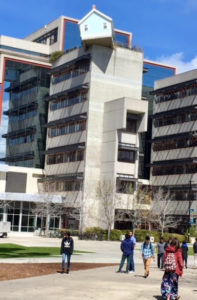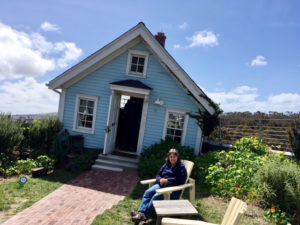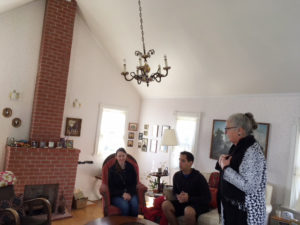 La versión en español está disponible aquí.
La versión en español está disponible aquí.
Last week I had the opportunity to travel around Southern California with my family. As any good author, I was attentive to narratives or experiences that could trigger my mind and heart, and result in a good, meaningful essay. Well, thankfully during my trip I had two of these experiences.
Last Saturday, we spent the day at Disneyland. I do not visit these theme parks often. In fact, throughout my life I have only been to a Disney park four times. We had a delightful time, close to perfection, with one exception. For some reason, some of the rides were malfunctioning. They would just stop in the middle of the ride. This happened to us twice. Thankfully, this did not occur on any roller coasters or audacious rides.
One of the times, my daughter and I were riding the “It’s a Small World” ride. This is one of Disney’s long-standing classic rides. I remember riding it with my mom, dad and siblings when I was 10 years old. Let me describe it for the readers who have never been there. The participant boards a little boat with approximately 15 other passengers and is taken on a voyage to different parts of the world. Participants imagine to be travelling as they see characters (dolls) from diverse places and nationalities, dressed in native customs. All of the dolls are singing “It’s a Small World,” the classic song by Richard M. and Robert B. Sherman, in their original language. The tune is so catchy that after a couple of minutes in the ride, the visitor starts singing the song. Here are the lyrics:
It’s a world of laughter, a world of tears,
It’s a world of hopes, it’s a world of fears,
There’s so much that we share,
That it’s time we’re aware,
It’s a small world after all.
Chorus:
It’s a small world after all,
It’s small, small world.
There is just one moon and one golden sun,
And a smile means friendship to everyone,
Though the mountains divide,
And the oceans are wide.
It’s a small world after all.
My daughter, other passengers, and I were stuck for about 25 minutes inside this ride as these worldwide characters kept singing the same song, over and over again. As we waited for the ride to work again, we started to make some light jokes to relieve the tension and the frustration caused by this incident. However, as the time passed by, I was getting more and more annoyed with the song. It was loud and repetitive. At a certain point, I pretended to pull my hair, and I screamed: “I get it; it is small world that we have to share. Let me go.” My daughter and the passengers close by laughed, and I started to think: Do I really get it? Do we get it? If so, how do we share this small world?
 At that moment, I remembered another experience that I had two days before while visiting the University of California San Diego, where my daughter works as an academic coach. It is a beautiful campus with much art around it. We went to see a unique piece of art created by South Korean artist Do Ho Suh, called “Fallen Star.” The piece is a small house that seems to have fallen from the sky on top of the seventh floor of the Jacobs School of Engineering building. From the distance, the house presents a discordant panorama. It looks like a misplaced piece, unmatched with the rest of the building. In addition to this architectural dissonance, the house is tilted by five degrees.
At that moment, I remembered another experience that I had two days before while visiting the University of California San Diego, where my daughter works as an academic coach. It is a beautiful campus with much art around it. We went to see a unique piece of art created by South Korean artist Do Ho Suh, called “Fallen Star.” The piece is a small house that seems to have fallen from the sky on top of the seventh floor of the Jacobs School of Engineering building. From the distance, the house presents a discordant panorama. It looks like a misplaced piece, unmatched with the rest of the building. In addition to this architectural dissonance, the house is tilted by five degrees.
As visitors enter the small house, they experience its unbalance, and must hold on to the doorknob or a piece of furniture in order to find some stability. The tour guide explained that this experience of being off-balance is how the artist felt when he came to the United States to study as an international student. Every day he experienced this off-balance reality, and had to reorient himself in order to survive in this new environment. The tour guide also highlighted that the only part of the house that was in balance was a chandelier hanging from the ceiling. Due to the force of gravity, the chandelier maintains the right angle, and serves as a point of reference of what is true reality.
 Do Ho Suh’s creative piece represents what many foreigners (immigrants or refugees), experience as they move to a new land — a life that is constantly off-balance, and an arduous effort to reorient themselves in order to survive.
Do Ho Suh’s creative piece represents what many foreigners (immigrants or refugees), experience as they move to a new land — a life that is constantly off-balance, and an arduous effort to reorient themselves in order to survive.
Survive? Are the foreigners the only ones who need to survive?
There’s so much that we share,
That it’s time we’re aware,
It’s small world after all.
The truth of the matter is that we human beings are indeed stuck, as in my ride, in this small world that we have to share in order to survive. How can we do it successfully? Do Ho Suh offers some wise strategies as he invites us to recognize the many things that make us experience reality in an unbalanced way. In my view, these things may be temptations that we may face related to power, control, money, possessions or wrong/inappropriate interpersonal relationships that may lead to issues of sexism, classism, racism and/or ageism. The only way out is to reorient ourselves by looking at the chandelier that holds the right, true angle of reality.
 As human beings in general, the chandelier may be our commonalities, the things that we share that will lead us not only to survive, but also to thrive together. We desire peace, food, shelter, clean water, education for our kids, and a hopeful future. How do we work universally towards these shared goals?
As human beings in general, the chandelier may be our commonalities, the things that we share that will lead us not only to survive, but also to thrive together. We desire peace, food, shelter, clean water, education for our kids, and a hopeful future. How do we work universally towards these shared goals?
For Christians, these experiences of being off-balance and reorienting ourselves should be a constant, too. According to the Bible, Christians are foreigners who are citizens of heaven. As such, we struggle with world’s values, and need to be reoriented constantly towards the values of God’s reign.
How do we do this? What is the chandelier that shows us the right angle? I believe that the only chandelier that can give us light, and provide us with the right angle of reality is the Holy Trinity.
As we resist temptations, and reorient ourselves in order to exist together in our shared world, we need to remember that God created all human beings in God’s own image. Thus, as bearers of God’s image, all human beings have the same value and dignity, and must be treated accordingly. Jesus, the son, God’s most complete revelation (Hebrews 1:1-3), modeled how to treat each other with love, mercy and compassion. Finally, the Holy Spirt empowers us to live a life patterned after Jesus, where the Spirit’s fruit (love, joy, peace, forbearance, kindness, goodness, faithfulness, gentleness, and self-control), must mark the way in which Christians interact with each other and the world.
It is small world after all, and we must be aware that we will survive or perish together. May we discern the right way, and be brave enough to act accordingly. A good action in our circle of influence can have a ripple effect, and go a long way. With God’s help, let’s do our part.
